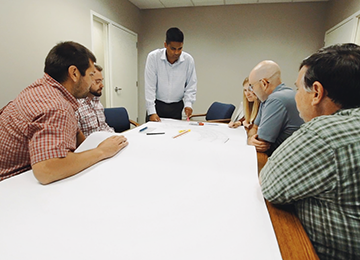During the last week of August we had approximately 30 seismographs placed around the Washington, D.C. area to monitor construction vibrations. Their purpose was to record the potential effects of construction on nearby structures. When the earthquake occurred in Mineral, VA, these seismographs recorded a lot of data. While our seismographs are not primarily designed to record earthquakes, it was very interesting to compare the vibration data caused by the earthquake with the vibration criteria we use for construction monitoring
One of the first questions or comments I get when recording construction vibrations is “What was the vibration level on the Richter Scale?” The truth is there’s no real way to correlate our vibration data to the Richter Scale. In its simplest form, the Richter Scale is a way to quantify the amount of energy released by an earthquake. Seismographs measure the intensity of a vibration event at any given location. The easiest way to explain intensity is this: a person sitting in their office in Central Virginia on August 23rd felt a much stronger earthquake than a person sitting in an office in Pennsylvania. They both felt the same Magnitude 5.8 earthquake, but the intensity at each location was very different.
In reviewing the vibration data we recorded on September 23, 2011, some items immediately stood out. For my colleagues who work on the West Coast, I’m certain they see these things all the time, but for those of us living on the East Coast who don’t have the opportunity to experience a significant earthquake but once a lifetime, the data we collected is really interesting. For example, take a look at the attached seismograph report, and look at the vibration frequency from the earthquake. While I’ve always known that earthquake vibrations are a low-frequency event, it was nice to see this theory brought to life, with peak levels coming in at frequencies between two-four cycles per second (Hz). To put this in perspective, most construction vibrations typically have frequencies of 20-80 Hz. The other thing that stood out is that the horizontal movements (“Long” in this event report) had intensities that were about two times the intensity of the vertical movements. This was consistent throughout the entire D.C. area. Of course, earthquake horizontal movement is typically greater than vertical movement, so this is further confirmation of what we would expect to see.
The vibration monitoring services that we have deployed our instruments for are specifically intended to determine if vibrations have the potential to cause damage. One of the things that we use to determine this is to compare the recorded levels to what is called the USBM damage criteria[1]. The attached event report shows the USBM curve along with the frequency and amplitude data from the earthquake plotted against it. As you can see, the earthquake generated intensities that were above this damage criteria. While this does not mean that damage has actually occurred, it does mean that the potential for damage exists. This is consistent with our building observations: some structures have exhibited conditions consistent with vibration damage, while others show no apparent change at all.
Paul Pinkerton is a geophysicist with the ECS Frederick, Maryland office. He can be contacted at ppinkerton@ecslimited.com.
[1] Siskind, D.E., M.S. Stagg, J.W. Kopp and C.H. Dowding, RI8507: Structure Response and Damage Produced by Ground Vibration from Surface Mine Blasting, U.S. Department of the Interior, Bureau of Mines, 1980.

